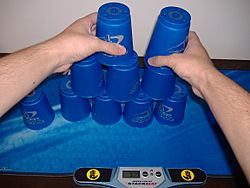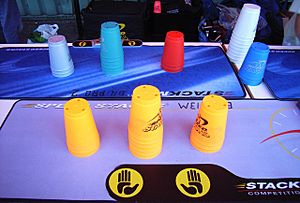Sport stacking facts for kids

A 1-10-1 being upstacked as part of the cycle stack
|
|
| Highest governing body | World Sport Stacking Association |
|---|---|
| Nicknames | Cup stacking, speed stacking |
| First played | 1981, Oceanside, California, U.S. |
| Registered players | 618,394 (number of worldwide participants in the Guinness World Record set in 2015) |
| Characteristics | |
| Contact | No |
| Team members | Individual, doubles, teams of 4 or 5 |
| Mixed-sex | Yes, but in separate divisions |
| Type | Indoor, Outdoor |
| Equipment | Cups, mat, timer |
| Presence | |
| Country or region | Worldwide |
| Olympic | AAU Junior Olympic Games |
Sport stacking, also called cup stacking or speed stacking, is a fun and fast sport. It's played by individuals or teams. The goal is to stack special cups in certain patterns as quickly as you can. You usually use 9 or 12 cups.
The cups are made to help you go super fast. Players arrange the cups in specific ways. These patterns often look like pyramids made of 3, 6, or 10 cups. You can compete against a timer or another player. The World Sport Stacking Association (WSSA) sets all the rules for this exciting sport.
Contents
Equipment for Sport Stacking
To play sport stacking, you need special equipment. Official sport stacking cups are designed to be very fast. They have features that stop them from sticking together. This helps competitors stack and unstack them quickly.
Inside the cups, there are small ridges. These ridges keep the cups slightly separated when they are stacked. The outside of the cups has a light texture. This makes them easier to grip. The inside surfaces are very smooth, so they slide past each other easily.
The tops of the cups have small holes. These holes let air escape. This prevents the cups from getting stuck together. Some special cups even have no tops at all. This reduces air resistance even more.
For official competitions, people use StackMat timers. These timers are very accurate. They are also used for practice or just for fun.
There are also special weighted training cups. They are called "Super Stacks" and are made of metal. Athletes use them before competing. The extra weight makes regular cups feel lighter during a competition.
Jumbo Stacks are bigger versions of the cups. They are often used in school gym classes. They are not usually for home use or competitions.
How to Play: Sport Stacking Rules
The WSSA rule book defines three main sequences for official events. These are the patterns you must stack.
- 3-3-3: This sequence uses nine cups. You make three separate stacks of three cups each. You stack them up from left to right or right to left. Then, you unstack them back into their starting positions. You must unstack them in the same order.
- 3-6-3: This sequence uses 12 cups. It's like the 3-3-3, but the middle stack has six cups instead of three. You stack each group of cups up. You can go from left to right or right to left. Then, you unstack them in the same order.
- Cycle: This sequence also uses 12 cups. It's the most complex. First, you build a 3-6-6 stack. Then you unstack it. Next, you build a 6-6 stack and unstack that. Finally, you build a 1-10-1 stack. All cups are then unstacked back to their starting positions.
Benefits of Sport Stacking
People who play sport stacking say it helps with many skills. It can teach you cooperation if you play in teams. It also helps you use both hands equally well, which is called ambidexterity. A big benefit is improving your hand–eye coordination.
A study in 2004 by Brian Udermann showed that stacking helps. It can improve hand-eye coordination and reaction time. It can make them up to 30% better!
Another study looked at how sport stacking affects the brain. It found that stacking uses both sides of your brain. When you use your left hand, your right brain hemisphere is more active. When you use your right hand, your left brain hemisphere is more active.
Other research also supports that stacking improves reaction time. One study found that even just one hour of practice can make a difference. Sport stacking can even help you get better at other sports. This is because it boosts your hand-eye coordination.
A study at Towson University looked at how stacking affects reading. They found that sport stacking might help 5th graders improve their reading comprehension. This suggests that using both hands in activities like stacking can help with learning.
Sport Stacking Competitions
Most sport stacking competitions are for kids. There are also special groups for "Special Stackers." These are competitors with disabilities.
The WSSA has strict rules for setting world records.
- You must use official WSSA-approved cups.
- A StackMat and a tournament display must be used for timing.
- The attempt must be recorded on video. This helps with checking the record.
- Two judges must watch each try. One is the Head Judge. After each try, they decide if it was a good run. They use color-coded cards to show the result. Green means a clean run. Yellow means there's a question, and they need to check the video. Red means it was not a valid try.
- A judge cannot be a family member of the stacker. Also, they cannot be the stacker's instructor.
Competitions have 14 different age groups. These range from kids aged 6 and under to seniors aged 65 and up. State, national, and world records are all kept on the WSSA website.
World Records in Sport Stacking
Here are some of the fastest times ever recorded in sport stacking.
Male World Records
| Event | Time | Stacker |
|---|---|---|
| 3-3-3 | 1.322 | |
| 3-6-3 | 1.658 | |
| Cycle | 4.753 |
Female World Records
| Event | Time | Stacker |
|---|---|---|
| 3-3-3 | 1.424 | |
| 3-6-3 | 1.770 | |
| Cycle | 5.042 |
Combined World Records
These records are for events with more than one person.
| Event | Time | Stackers |
|---|---|---|
| Doubles | 5.798 | |
| 3-6-3 Relay | 12.187 | Pro Series E |



